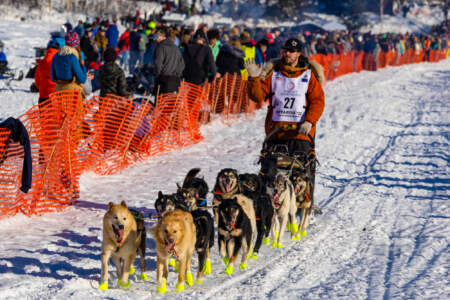Nome Points of Interest
Much of Nome’s gold was mined more than a century ago. Today’s treasure is of a different sort: searching out city landmarks like Anvil Rock or the protective sea wall, learning about famous people who lived here, and connecting with locals at a weekend movie or the public library. There’s a rich “nugget” of information about each of these points of interest, which makes Nome a very compelling place to visit.
Show Map
Points of Interest
Nome is becoming a well-known as a treasure for birders. The city is bounded by tundra on three sides and the Bering Sea coast on the other. Once the ice begins to break up, migration begins. Virtually the entire area of the Seward Peninsula that is accessible by road from Nome is comprised of extremely valuable nesting areas for many bird species, including most North American waterfowl.
Relax in some of Alaska’s hot springs, naturally heated by the earth below
Every March, mushers and their canine teams speed across some 1,000 miles of frozen terrain — from the town of Willow to the northern city of Nome. And whether you’re a die-hard fan or a curious traveler, experiencing the Iditarod is not only a thrill, but also a way to get an insider’s look at Alaskan culture and adventure.
Especially during its early years, Nome had brushes with a surprising number of famous people. Some of them gained fame while in Nome. Others were well known before they got here. You’ll recognize some names. Others have faded with the passage of time, as their exploits fall further and further into the past.
With 18,000 books and a new home, Nome’s public library offers a place to browse and encouragement to pursue reading “at all ages and stages.” Stop by to check your email, read a magazine or make an appointment to review rare books on Alaska and the Seward Peninsula. Closed Sundays and holidays.
On the left as you head north are remnants of an abandoned reindeer corral that was first constructed by the Bureau of Indian Affairs in the 1970s for a reindeer herding demonstration project. The local Sitnasuak Native Corporation took over the corral in the early 1980s and ran a herd of about 750 animals for several years. The corral fell into disuse after Sitnasuak got out of the business and distributed the reindeer to other herders.
Pilgrim Hot Springs is a green oasis for Nome residents who yearn for trees and the sound of leaves rustling in the wind. Pilgrim has historic value too, first as a gold rush resort and later as a Catholic mission. Then there are the springs themselves. At 178 degrees F, they are a literal hot spot in the Arctic north.
Anvil Rock perches above Nome, an early landmark for gold miners and an easy hike for those who want to take in spectacular views of Nome, the Bering Sea, and the Kigluaik Mountains. Its resemblance to a blacksmith’s anvil generated names for many nearby landscape features, including Anvil Mountain and Anvil Creek. The hike also promises a good chance to see musk oxen, birds, and maybe even reindeer or red fox. ...more
Nome’s “crown jewel,” Anvil City Square is a large open green space popular for picnics and community celebrations. It’s also where you can see Old St. Joe’s Hall, the largest gold pan in the world, statues of the “Three Lucky Swedes” and the young Inupiaq boys who helped them find gold in 1899.
Reindeer round-ups are held at the corral once or twice a year.
Nome’s Gold Coast Cinema shows films Friday, Saturday and Sunday, with matinees on both Saturday and Sunday. The theatre has first-run movies as well as independent films, and typically offers two titles per week. One quirk? Concessions include a Subway sandwich shop, giving you more options than just popcorn and candy.
Nome’s most famous and historic street runs parallel with the coast, having sprung up close to the city’s original tent city. Although none of its original buildings remain, Front Street continues to make history as the endpoint of the 1,049-mile Iditarod Sled Dog race.
The town of Solomon has had several names and locations since the Fish River tribe established a fishing and hunting camp called Amutach on a sandbar between the Bonanza and Solomon Rivers. In 1899, when gold was discovered in the gravels of the Solomon River, a mining boomtown sprang up on the site with a post office, several saloons, a railroad terminal, a ferry dock, and over 2,000 residents. Thirteen large dredges worked the Solomon River. ...more
Extending more than half a mile along the coastline of Nome, the 18-foot tall seawall is a silent protector, keeping storm surges from flooding the city’s buildings along Front Street and further inland.
No matter what place a team finishes, the Iditarod burled arch is a symbol of an arduous journey successfully completed, a job well done, and of a long-awaited rest – for both dogs and mushers –just up ahead. See it above Nome’s Front Street during Iditaord season in March, or near City Hall the rest of the year.
The Nome area is one of the few accessible places in the world where you can observe muskoxen in their natural habitat. They are easy to see and photograph in and around town. You can also take a little muskox home with you; garments made from their soft and warm under fur are a luxury souvenir worth finding.










